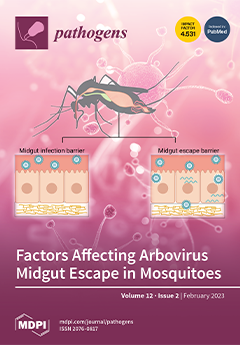Beneficial bacteria with antibacterial properties are attractive alternatives to chemical-based antibacterial or bactericidal agents. Our study sourced such bacteria from horticultural produce and environments to explore the mechanisms of their antimicrobial properties. Five strains of
Pseudomonas fluorescens were studied that possessed antibacterial activity against the pathogen
Listeria monocytogenes. The vegetative culture of these strains (
Pseudomonas fluorescens-PFR46I06,
Pseudomonas fluorescens-PFR46H06,
Pseudomonas fluorescens-PFR46H07,
Pseudomonas fluorescens-PFR46H08 and
Pseudomonas fluorescens-PFR46H09) were tested against
Listeria monocytogenes (n = 31),
Listeria seeligeri (n = 1) and
Listeria innocua (n = 1) isolated from seafood and horticultural sources and from clinical cases (n = 2) using solid media coculture and liquid media coculture. All
Listeria strains were inhibited by all strains of
P. fluorescens; however,
P. fluorescens-PFR46H07,
P. fluorescens-PFR46H08 and
P. fluorescens-PFR46H09 on solid media showed good inhibition, with average zones of inhibition of 14.8 mm, 15.1 mm and 18.2 mm, respectively, and the other two strains and
P. fluorescens-PFR46H09 had a significantly greater zone of inhibition than the others (
p < 0.05). There was no inhibition observed in liquid media coculture or in
P. fluorescens culture supernatants against
Listeria spp. by any of the
P. fluorescens strains. Therefore, we hypothesized that the structural apparatus that causes cell-to-cell contact may play a role in the ejection of ant-listeria molecules on solid media to inhibit
Listeria isolates, and we investigated the structural protein differences using whole-cell lysate proteomics. We paid special attention to the type VI secretion system (
TSS-T6SS) for the transfer of effector proteins or bacteriocins. We found significant differences in the peptide profiles and protein summaries between these isolates’ lysates, and PFR46H06 and PFR46H07 possessed the fewest secretion system structural proteins (12 and 11, respectively), while PFR46H08 and PFR46H09 had 18 each.
P. fluorescens-PFR46H09, which showed the highest antimicrobial effect, had nine
tss-T6SS structural proteins compared to only four in the other three strains.
Full article






